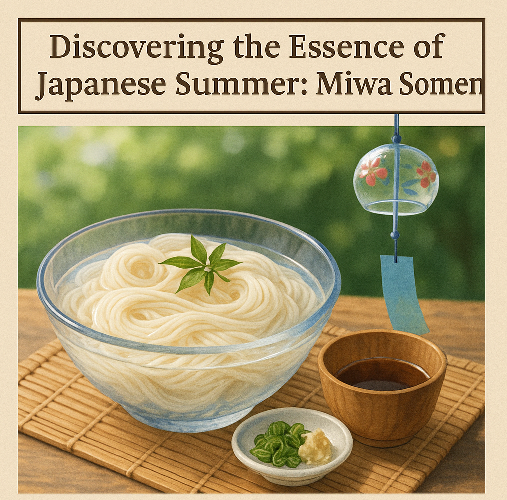
When summer arrives in Japan, so too does the craving for somen — delicate, white wheat noodles often served chilled with a savory dipping sauce. Among the many varieties, one name stands out with centuries of history and craftsmanship: Miwa Somen, a traditional specialty from Nara Prefecture.
Miwa Somen is said to be the oldest somen in Japan, with a legacy that dates back over 1,200 years. It originated in the town of Miwa, nestled at the foot of sacred Mount Miwa, a place steeped in spiritual and cultural significance. According to legend, somen was first offered to the gods at Miwa Shrine, and the practice of making these noodles has been passed down through generations ever since.
What sets Miwa Somen apart is its exceptional thinness and texture. Each strand is carefully hand-stretched by skilled artisans using a traditional method called tenobe (hand-pulled). Despite their delicate appearance, Miwa Somen noodles are surprisingly firm and resilient, offering a satisfying bite and smooth mouthfeel.
On a hot summer day, a simple meal of chilled Miwa Somen, served with tsuyu (dipping sauce), finely chopped scallions, and grated ginger, captures the ephemeral beauty of the season. In Japanese homes, it’s a common sight to see families gather around a table or even enjoy nagashi somen — noodles flowing down a bamboo flume — in gardens or at summer festivals.
Eating Miwa Somen is not just a culinary experience; it’s a way to connect with Japanese history, craftsmanship, and seasonal rhythm. It’s a reminder that in Japan, food is more than sustenance — it’s a celebration of nature, tradition, and the fleeting joy of summer.
So if you’re looking to taste an authentic slice of Japanese summer, Miwa Somen is a perfect place to start — elegant, time-honored, and deeply rooted in the heart of Japan.
日本の夏の本質を発見する:三輪そうめん
日本に夏が訪れると、同時にそうめんを欲する気持ちもやってきます――繊細な白い小麦の麺で、よく冷やして旨味のあるつけ汁とともに供されます。数ある種類の中でも、何世紀もの歴史と職人技を持つひとつの名前が際立っています。それが、奈良県の伝統的な名産品である三輪そうめんです。
三輪そうめんは、日本最古のそうめんと言われており、その歴史は1200年以上前にさかのぼります。聖なる三輪山のふもとにある三輪の町に起源を持ち、そこは精神的・文化的に重要な場所です。伝説によると、そうめんは三輪神社の神々への供え物として最初に捧げられたとされ、その製法はそれ以来、代々受け継がれてきました。
三輪そうめんを特別なものにしているのは、その非常に細い麺と食感です。各麺は、手延べと呼ばれる伝統的な方法で、熟練の職人によって丁寧に手で引き延ばされます。その繊細な見た目にもかかわらず、三輪そうめんの麺は驚くほどしっかりとしていて弾力があり、満足感のある歯ごたえと滑らかな口当たりを提供します。
暑い夏の日には、冷たくした三輪そうめんを、つゆ(つけ汁)、細かく刻んだねぎ、おろし生姜とともにシンプルに味わうことで、季節のはかなき美しさを体験できます。日本の家庭では、家族がテーブルに集まり、あるいは庭や夏祭りで流しそうめん――竹の樋を流れる麺――を楽しむ光景がよく見られます。
三輪そうめんを食べることは、単なる食事ではありません。それは、日本の歴史、職人技、そして季節のリズムとつながる方法なのです。日本において、食べることは単なる栄養補給ではなく、自然、伝統、そして夏のつかの間の喜びを祝うことなのです。
もしあなたが本物の日本の夏の一端を味わってみたいと思うなら、三輪そうめんはまさにうってつけのスタート地点です――気品があり、時を超えた存在であり、日本の心に深く根ざしています。
